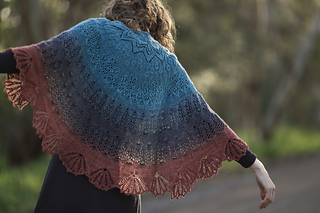patterns >  Nim Teasdale's Ravelry Store
Nim Teasdale's Ravelry Store
> Evoluta






Evoluta
Evoluta MKAL!
A semicircular lace shawl on the theme of change as a positive necessity, with flowing and evolving layers of lace and just enough texture to be interesting.
-
Suits intermediate to advanced knitters, with a similar skill level and feel to Don’t Panic.
-
Starting Sep 1, the pattern will be released in 6 parts. (Sent out on Sep 1, 5, 10, 15, 20, 25.) The KAL thread will run in the Nimble Knits group, and continue into October. (Update: now the MKAL is over, a single complete PDF in each language has been uploaded. The 6 MKAL parts will remain available for download until the end of October, after which they’ll be removed to make it easier to find the complete pattern.)
-
The pattern can be worked entirely from written directions, or charts with some notes.
-
WS rows are mostly purl with a bit of knit, but no lacey business.
-
The design has a wedge shaped construction forming a half circle, and the pattern includes instructions for adding extra wedges.
-
Please print pattern in colour, as some notes are colour coded for easier visual recognition.
-
Thanks to you, we raised $149 for MALPA!
Vielen Dank an Sabine von http://www.schafga.be/ für diese Übersetzung.
Yardage
The shawl is designed with one main ending point, and a series of extensions after that point (to avoid potential yarn wastage :).
For a smaller shawl, you can skip a 40 row section and jump ahead to the edge.
In light fingering, allow:
Main ending, row 200 (end chart 7) = 730m/800y
(If skipping 40 rows/chart 5 = 540m/590y)
First extension = 850m/930y
Longest possible = 1450m/1600y
A heavier fingering would use more yarn (~900y for main size), and begin with 3.25 needles. Catnach’s cobweb weight test used 696m for the largest possible size. (46.4g @ 1500m/100g)
Yarn
Lace to fingering, in a gradient, solid, or gentle semi-solid, and preferably a yarn that will hold a block well. (Wool, tencel, silk, cotton, etc.) Something slinky like VFA would work well. I’ve done 2 tests in The Blue Brick yarns, both slightly grabbier bases to test the design, and they’ve both worked beautifully.
Beads
Beads are marked on the charts. Bead placement isn’t explicitly included in the written pattern, however there are notes on how to incorporate them if you wish to. (222 beads per wedge +16 beside the border, or 904 for 4 wedges.)
Size:
Shawl depth. Mine was 150 x 75cm at main size, (120 x 60cm if taking the 40 row shortcut), and more if knitting absolutely everything.
Stitches:
Knit & purl.
Decreases: ssk & k2tog, left leaning, right leaning, and centred double decreases.
Increases: yo, kyok, and other make x number of sts into one stitch.
And one row where you’ll need to make 2 sts from 3 by working a sk2p (double decrease) and then working k1, p1 into the resulting st.
K: knit
P: purl
K2tog: knit 2 stitches together
SSK: slip 1 knitwise, repeat, knit 2 together through back loops
SK2P: slip 1, knit 2 sts together,
pass slipped st over (left leaning double decrease)
CDD (s2kp): slip 2 tog knitwise, knit 1, pass slipped sts over
(central double decrease)
SSKSP: work as for ssk, return this st to left needle, pass next st over, slip to right needle (right leaning double dec)
YO: yarn over (for double yo, work as k1, p1 on WS)
CO: cast on (backward loop)
KYOK: knit, yo, knit into same st
M5: make 5 sts from 1 st: k,yo,k,yo,k
M7: make 7 from 1 st: k,yo,k,yo,k,yo,k
M9: make 9 from 1 st: k,yo,k,yo,k,yo,k,yo,k
2 sts from 3: work as for sk2p, return st to left needle and work k1, p1 into resulting st, decreasing 3 sts to 2
524 projects
stashed
970 times
524 projects
stashed
970 times
203 projects
stashed
431 times
- First published: August 2020
- Page created: August 1, 2020
- Last updated: November 21, 2024 …
- visits in the last 24 hours
- visitors right now





